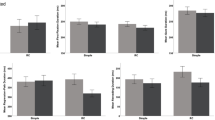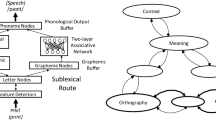Abstract
A series of eye-tracking experiments investigated priming in natural language understanding. Intralexical spreading activation accounts of priming predict that the response to a target word will be speeded (i.e., primed) when strong associates appear prior to the target. Schema-based priming accounts predict that priming will occur when the target word is a component of an activated schema or script. Situation model accounts predict that priming will occur when a target word can be integrated easily into an evolving discourse representation. In separate experiments, we measured the effect of associated words, synonyms, and identity primes on processing times for subsequently encountered target words. Our designs crossed prime type (e.g., synonyms vs. unassociated words) with semantic plausibility (i.e., the target word was a plausible vs. an implausible continuation of the sentence). The results showed that identity primes, but not associates or synonyms, primed target words in early measures of processing like first fixation and gaze duration. Plausibility effects tended to emerge in later measures of processing (e.g., on total reading time), although some evidence was obtained for early effects of semantic plausibility. We propose that priming in naturalistic conditions is not caused by intralexical spreading activation or access to precompiled schemas.
Similar content being viewed by others
REFERENCES
Carroll, P., & Slowiaczek, M. L. (1986). Constraints on semantic priming in reading: A fixation time analysis. Memory & Cognition, 14, 509–522.
Collins, A. M., & Loftus, E. F. (1975). A spreading-activation theory of semantic processing. Psychological Review, 82, 407–428.
Coulson, S., Van Petten C., Federmeier, K., Folstein, J., Weckerly, J., & Kutas, M. (2000, March). Lexical and sentential context effects: An ERP study of the difference between life and death and life in prison. Paper presented to the 13th Annual CUNY Conference, San Diego, California.
Dell, G. S., & Reich, P. A. (1981). Stages in sentence production: An analysis of speech error data. Journal of Verbal Learning and Verbal Behavior, 20, 611–629.
Duffy, S. A., Henderson, J. M., & Morris, R. K. (1989). The semantic facilitation of lexical access during sentence processing. Journal of Experimental Psychology: Learning, Memory, & Cognition, 15, 791–801.
Foss, D. J. (1982). A discourse on semantic priming. Cognitive Psychology, 14, 590–607.
Foss, D. J., & Ross, J. R. (1983). Great expectations: Context effects during sentence processing. In G. Flores D'Arcais & R. J. Jarvella (Eds.), The process of language understanding (pp. 169–191). Chichester, England: Wiley.
Foss, D. J., & Speer, S. R. (1991). Global and local context effects in sentence processing. In R. R. Hoffman & D. S. Palermo (Eds.), Cognition and symbolic processes: Applied and ecological perspectives (pp. 115–139). Hillsdale, NJ: Erlbaum.
Francis, W. N., & Kucera, H., (1967). A computational analysis of present day English. Cambridge, Massachusetts: MIT Press.
Hess, D. J., Foss, D. J., & Carroll, P. (1995). Effects of local and global context on lexical processing during language comprehension. Journal of Experimental Psychology: General, 124, 62–82.
Johnson-Laird, P. N. (1983). Mental models. Cambridge: Cambridge University Press.
Kawamoto, A. H. (1993). Nonlinear dynamics in the resolution of lexical ambiguity: A parallel distributed processing account. Journal of Memory and Language, 32, 474–516.
Kintsch, W. (1998). Comprehension: A paradigm for cognition. Cambridge: Cambridge University Press.
Kintsch, W., & Mannes, S. M. (1987). Generating scripts from memory. In E. Van Der Meer & J. Hoffman (Eds.), Knowledge-aided information processing (pp. 61–80). Amsterdam: Elsevier.
Landauer, T. K. (1999). Latent semantic analysis: A theory of the psychology of language and mind. Discourse Processes, 27, 303–310.
Landauer, T. K., & Dumais, S. T. (1997). A solution to Plato's problem: The latent semantic analysis theory of acquisition, induction, and representation of knowledge. Psychological Review, 104, 211–240.
MacDonald, M. E., Pearlmutter, N. J., & Seidenberg, M. S. (1994). The lexical nature of syntactic ambiguity resolution. Psychological Review, 101, 676–703.
Mandler, J. M. (1992). How to build a baby II: Conceptual primitives. Psychological Review, 99, 587–604.
Meyer, D. E., & Schvaneveldt, R. W. (1976). Meaning, memory structure, and mental processes. Science, 197, 27–33.
Morris, R. K. (1994). Lexical and message-level sentence context effects on fixation times in reading. Journal of experimental psychology: Learning, Memory, & Cognition, 20, 92–103.
Morris, R. K, & Folk, J. R. (1998). Focus as a contextual priming mechanism in reading. Memory & Cognition, 26, 1313–1322.
Pickering, M. J., & Traxler, M. J. (1998). Plausibility and recovery from garden paths: An eyetracking study. Journal of Experimental Psychology: Learning Memory, & Cognition, 24, 940–961.
Pickering, M. J., Traxler, M. J., & Crocker, M. W. (2000). Ambiguity resolution in sentence processing. Evidence against frequency-based accounts. Journal of Memory and Language, 43, 447–475.
Posner, M. I., & Raichle, M. E. (1997). Images of mind. New York: Scientific American.
Schank, R. C. (1982). Dynamic memory. Cambridge: Cambridge University Press.
Schank, R. C., & Abelson, R. P. (1977). Controlled and automatic human information processing: I. Detection, search, and attention. Psychological Review, 84, 1–66.
Seidenberg, M. S., Tanenhaus, M. K., Leiman, J. M., & Bienkowski, M. (1982). Automatic access of the meanings of ambiguous words in context: Some limitations of knowledge based processing. Cognitive Psychology, 14, 489–537.
Sereno, S. C. (1995). Resolution of lexical ambiguity. Evidence from an eye movement priming paradigm. Journal of Experimental Psychology: Learning, Memory, & Cognition, 21, 582–595.
Sereno, S. C., & Rayner, K. (1992). Fast priming during eye fixations in reading. Journal of Experimental Psychology: Human Perception and Preformance, 18, 173–184.
Simpson, G. B., Peterson, R. R., Casteel, M. A., & Burgess, C. (1989). Lexical and sentence context effects in word recognition. Journal of Experimental Psychology: Learning, Memory, & Cognition, 5, 88–97.
Stanovich, K. E., & West, R. F. (1979). Mechanisms of sentence context effects in reading: Automatic activation and conscious attention. Memory & Cognition, 7, 77–85.
Stanovich, K. E., & West, R. F. (1981). The effect of sentence context on ongoing word recognition: Tests of a two-process theory. Journal of Experimental Psycholoy: Human Perception & Performance, 7, 658–672.
Stanovich, K. E., & West, R. F. (1983). On priming by a sentence context. Journal of Experimental Psychology: General, 112, 1–36.
Swinney, D. A. (1979). Lexical access during sentence comprehension: (Re)consideration of context effects. Journal of Verbal Learning and Verbal Behavior, 18, 645–659.
Traxler, M. J., Bybee, M. D., & Picketing, M. J. (1997). Influence of connectives on language comprehension: Eye-tracking evidence for incremental interpretation. Quarterly Journal of Experimental Psychology A, 50, 481–497.
Traxler, M. J., & Foss, D. J. (2000). Facilitated integration and sentence constraint accounts of priming in sentence comprehension. Journal of Experimental Psychology: Learning, Memory & Cognition, in press.
Traxler, M. J., & Pickering, M. J. (1996). Plausibility and the processing of unbounded dependencies: An eye-tracking study. Journal of Memory and Language, 35, 454–475.
Traxler, M. J., Pickering, M. J., & Clifton, C., Jr. (1998). Adjunct attachment is not a form of lexical ambiguity resolution. Journal of Memory and Language, 39, 558–592.
Trueswell, J. T., & Kim, A. E. (1998). How to prune a garden path by nipping it in the bud: Fast pruning of verb argument structures. Journal of Memory and Language, 39, 122–123.
Trueswell, J. T., Tanenhaus, M. K., & Kello, C. (1993). Verb specific constraints in sentence processing: Separating effects of lexical preference from garden paths. Journal of Experimental Psychology: Learning, Memory, & Cognition, 19, 528–553.
West, R. K., & Stanovich, K. E. (1982). Source of inhibition in experiments of the effect of sentence context on word recognition. Journal of Experimental Psychology: Learning, Memory, & Cognition, 25, 385–399.
Whitney, P., McKay, T., Kellas, G., & Emerson, W. A., Jr. (1985). Semantic activation of noun concepts in context. Journal of Experimental Psychology: Learning, Memory, & Cognition, 25, 385–399.
Author information
Authors and Affiliations
Rights and permissions
About this article
Cite this article
Traxler, M.J., Foss, D.J., Seely, R.E. et al. Priming in Sentence Processing: Intralexical Spreading Activation, Schemas, and Situation Models. J Psycholinguist Res 29, 581–595 (2000). https://doi.org/10.1023/A:1026416225168
Issue Date:
DOI: https://doi.org/10.1023/A:1026416225168




